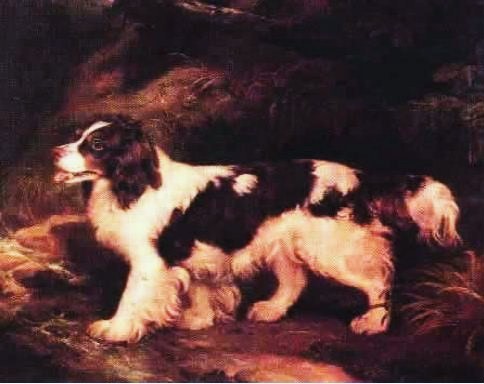
Preservation/heritage breeders always seek to improve their lines because as the old saw goes, “there is no perfect dog.” Nevertheless, the goal of each litter is to produce better than the parents.
We doubt anyone breeds to replace their breed, however, that is precisely what happened to the now extinct English Water Spaniel.
In General History of Quadrupeds from 1824, the English wood-engraver and natural history author, Thomas Bewick wrote of the breed, “Its form that is elegant, its hair beautifully curled or crisped, its ears long, and its aspect mild and sagacious.” He went on to praise its ability in water, as well as its faithfulness, obedience, biddability and docility.
A more detailed description of the English Water Spaniel showed up in an issue of The Countryman’s Weekly in 1896. According to the article, the spaniel weighed between 30-40 pounds, looked like a cross between a Springer Spaniel, Poodle, and a Collie, and was most commonly black, and white and liver.
It sounded like the perfect dog, and during its time, it was widely used for hunting waterfowl and duck. Indeed, one description said the spaniel was known for its ability to “dive like a duck.” Perhaps that is why the English Water Spaniel was used in the creation of other breeds only to be ultimately eclipsed by them, particularly by the Flat Coated Retriever and Curly Coated Retriever. Later still, some owners crossed their Curly-Coated Retrievers to the old English Water Spaniels, and offspring factored into the background of the American Water Spaniel.
Initially, the Kennel Club offered a class for “Water spaniels other than Irish” since the English Water Spaniel didn’t have a standard, per se, and the judging was described as “chaos” by Hugh Dalziel in British Dogs: Their Varieties, History, Characteristics, Breeding, Management, And Exhibition in 1897. He added, “I do not believe the breed is lost, but that scattered throughout the country there are many specimens of the old English water spaniel, which it only requires that amount of encouragement to breeding which it is in the power of show committees to give to perpetuate the variety and improve its form.” Presciently, Dalziel worried that the English Water Spaniel would be absorbed into other Spaniel breeds. And it was.
By the last decade of the 19th century, the Spaniel Club acknowledge its existence, and some dogs did show up at early Victorian dog shows, but the breed was close to vanishing. From 1891 to 1903, only fourteen dogs were recorded, though one source writes that the last English Water Spaniel was registered with the UK’s Kennel Club in 1886. Wikipedia (yes, we know) writes that the last specimen was seen in the 1930s.
What a pity for a breed thought to have been mentioned by Shakespeare as the ‘water rug’ in Macbeth, and again in Act III Scene 1 of The Two Gentlemen of Verona when Launce says of his love, “She hath more qualities than a water-spaniel.”
In the end, there wasn’t enough interest to save the breed when attention was snagged by newer breeds.
Image: English Water Spaniel (1815) by Ramsay Richard Reinagle (1775–1862) is a “faithful photographic reproduction of a two-dimensional, public domain work of art and is considered by Wikipedia to be in the public domain because it is a reproduction of a two-dimensional public domain work of art
